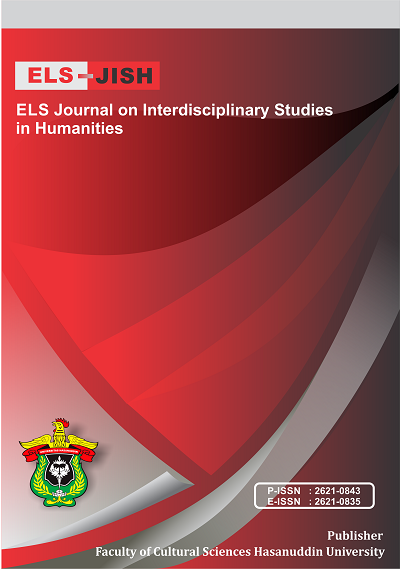Forms and Functions of Indonesian-English Code Switching: A Case Study of Elites in Makassar City
DOI:
https://doi.org/10.34050/elsjish.v5i3.23155Keywords:
Code Switching, Elites in Makassar, Indonesian-English, Linguistic StudiesAbstract
The phenomenon of code switching is one of the many social contexts that can help any interaction with the transition from one language to another. The aims of this research are to find out the general patterns of linguistic configuration and socio-pragmatic functions of Indonesian-English code switching. This research used descriptive qualitative and quantitative and the data were collected from 40 elites of different professions in four different types of interactions; seminars, meetings, dialogues on TV, and chitchats employing a direct observation technique including recording and jotting down, and questionnaires. The result of this research is demonstrated that code switching is a crucial phenomenon for a multilingual society. It plays a significant role in governing the social interaction of the community because it has a very wide spectrum of socio-pragmatic implication which significantly contribute to the lives of man whether as an individual being or as a social one
References
Azuma, S. (1997). Meaning and form in code-switching. Trends In Linguistics Studies And Monographs, 106, 109-124.
Bachriani, B., Yassi, A. H., & Rahman, F. (2018). A Comparative Study of Euphemism in English and Buginese: Pragmatic Stylistics Contexts. ELS Journal on Interdisciplinary Studies in Humanities, 1(4), 429-440.
Brown, P., Levinson, S. C., & Levinson, S. C. (1987). Politeness: Some universals in language usage (Vol. 4). Cambridge university press.
Creswell, J. W. (2010). Research design pendekatan kualitatif, kuantitatif, dan mixed. Yogyakarta: pustaka pelajar.
GUMPERZ, J. J. (1976) The sociolinguistic significance of conversational code-switching. In Cook-Gumperz, J and Gumperz, J. J. (Eds), Papers on Language and Context (Working Paper 46), pp. l-46. University of California Language Behavior Research Laboratory, Berkeley.
Gumperz, J.J. (1977). The Sociolinguistic significance of conversational code switching. RELC Journal. 8(2): 1-34.
Gumperz, J. J. (1982). Discourse strategies (No. 1). Cambridge University Press.
Gibbons, J. (1987). Code-mixing and code choice: A Hong Kong case study (Vol. 27). Clevedon: Multilingual Matters.
JOSHI Aravind (1985), Processing of sentences with intrasential code switching, in: David R. DOWTY, Lauri KATTUNEN, & Arnold M. ZWICKY (eds.), Natural language parsing: Psychological, computational and theoretical perspectives, Cambridge, Cambridge University Press
Lorente, B. P. (2000). Revisiting Taglish na naman: A congruence approach to Tagalog-English code-switching. Philippine journal of linguistics, 31(1), 25-37.
Marasigan, E. (1983). Code-switching and code-mixing in multilingual societies (Vol. 7). Singapore University press.
McClure, E. (1997). The relationship between form and function in written national language-English codeswitching: Evidence from Mexico, Spain and Bulgaria. Trends In Linguistics Studies And Monographs, 106, 125-152.
McConvell, P. (1988). Mix-im-up: Aboriginal code-switching, old and new. Codeswitching: Anthropological and sociolinguistic perspectives, 48, 97-149.
Myers-Scotton, C. (1993a [1997]). Duelling languages: Grammatical structure in codeswitching. Oxford, UK: Oxford University Press.
Myers-Scotton, C. (1993). Common and uncommon ground: Social and structural factors in codeswitching. Language in society, 22(4), 475-503.
Nishimura, M., & Yoon, K. K. (1998). Head directionality and intrasentential code-switching: A study of Japanese Canadians and Korean Americans’ bilingual speech. Japanese/Korean linguistics, 8, 121-130.
Poplack, S. (1980). Sometimes i’ll start a sentence in spanish y termino en espanol: toward a typology of code-switching1.
Rahman, F., & Weda, S. (2019). Linguistic deviation and the rhetoric figures in Shakespeare’s selected plays. XLinguage" European Scientific Language Journal", 12(1), 37-52.
Romaine, S. (1991). Last tango in Paris. Language & Communication, 11(1-2), 83-84.
Sankoff, D., & Poplack, S. (1981). A formal grammar for code‐switching. Research on Language & Social Interaction, 14(1), 3-45.
Sebba, M. (1998). A congruence approach to the syntax of codeswitching. International Journal of Bilingualism, 2(1), 1-19.
Scotton, C. M., & Ury, W. (1977). Bilingual strategies: The social functions of code-switching.
Scotton, C. M. (1993). Social motivations for codeswitching: Evidence from Africa. Clarendon Press.
Sukmawaty, Rahman, F.F, & Andini, C. (2022). Covid-19 Pandemic and Axiology of Communication: A Study of Linguistic Phenomena. IJISRT, 7(4).
Weda, S., Atmowardoyo, H., Rahman, F., & Sakti, A. E. F. (2021). Linguistic aspects in intercultural communication (IC) practices at a higher education institution in Indonesia. Eroupean Language Scientific Journal, 14, 2-6.
Yassi, A. H. (2001). Indolish (Indonesian-English): toward a typology of Indonesian-English code-switching. Journal of Language and Society, 1, 235-25212.
Yassi, A. H. (2003). Code Switching as a Communication Strategy in Indonesia-English Bilingual Discourse: A Congruence-Functional Approach to Indonesia-English Code-Switching. Makassar: PPSUnhas.
Downloads
Published
Issue
Section
License
Copyright (c) 2022 Wa Ode Hanafiah

This work is licensed under a Creative Commons Attribution-NonCommercial-ShareAlike 4.0 International License.






